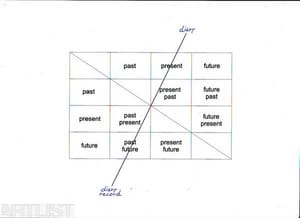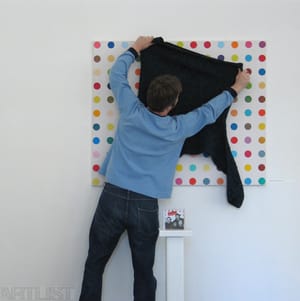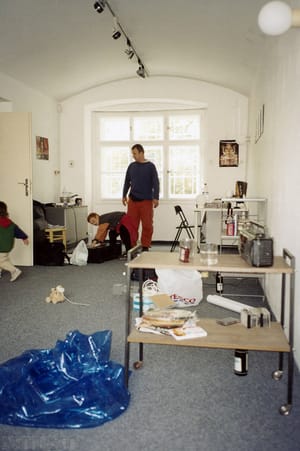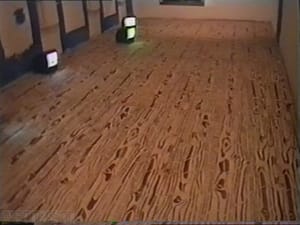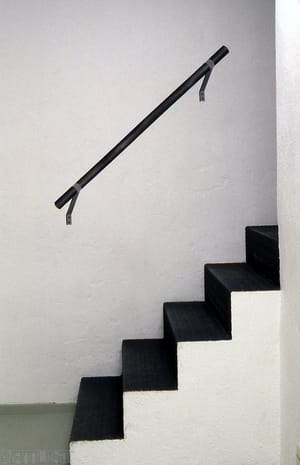- First Name
- Tomáš
- Surname
- Vaněk
- Born
- 1966
- Birth place
- Počátky
- Place of work
- Prague
- Website
- http://www.particip.tv
- i-datum
- ↳ Find in the VVP AVU database
- CSU Library
- ↳ Find in the catalogue
About artist
Tomáš Vaněk belongs to the generation that entered the Czech art scene in the mid 1990s. We could characterise his work as an examination of the space “between” – between reality and fiction, between the artist and viewer, between the creative and routine approach, between the private and the public, between seeing and knowing – and also between the object and its shadow.
After graduating from AVU Vaněk initiated with the group Headless Horseman (1999) a project for a display case on the street Komunard in Prague-Holešovice (as part of the exhibition Artworks in Public Spaces), which was to confront the art processes with the street's everyday life. The group PAS (2000) then continued in this activity, expanding it to other European cities as a form of confrontation with another cultural environment.
The openness which characterized this is also typical for Vaněk’s “Particip” projects. As the title itself suggests, Vaněk wants to activate the viewers’ perceptions and participation in interpreting the work. He mainly uses the technique of spray-painting over templates – on gallery walls and in public spaces he spray paints objects that appear real, which creates a certain tension between reality and fiction. Although spray-painting over templates is a method typical for street art, Vaněk depicts objects that typically belong to a given environment (e.g. doorbells - Particip no. 8, hydrant, electrical lighting, hammered nail, etc.) or theoretically could be on this place (inappropriately looking wooden cottage door in a gallery space – e.g. Veletržní Palace, Futura), creating shifts in our perception and expectation. We could borrow the definition of human action as “tactics” from de Certeau (The Practice of Everyday Life) for Vaněk’s spray-painting approach: in contrast to a "strategy” which demands its own place, autonomous language and sovereign position, a tactic does without its own place, appears in isolated actions, uses "occasions", depends on them and is thus inevitably mobile. Vaněk’s particips work similarly, depend on circumstances, and via the individual actions enter a real space and demonstrate that the "space is a practiced place" (de Certeau).
In another case, in the My Škoda Car project (Particip no. 18), Vaněk used parts of his own disassembled car as a template for creating a picture on the wall in which the spray-painted outlines of the individual parts created compositions of a somewhat abstract nature, the functional aspect changing into a purely aesthetical one, while again preserving a certain tension of the sphere “between” – between two ways of interpretation.
Examples of "participation art" are certainly Particip no. 67, in which Vaněk invites viewers to take over the creation of a comic strip, Particip no. 39, a collection of sorts of descriptions of everyday situations, feelings and paradoxes of thought which are seemingly faintly familiar to all of us, or Particip no. 15 in which a visitor of the Municipal Library can sign out a notebook with Vaněk spray-painted templates. In this last case the artwork entered a different system and became a direct part of the system of normal operation (once again in the "between" area). In the notebooks that could be borrowed at the library, Vaněk also focused on the possibilities of perception (transformations of a sign when quickly leafing through). This is a principle also used in Particip no. 14 (peripheral animation of a dart spray-painted on the pillars of a tram bridge), and later in examining the limits of the field of vision.
In recent years Vaněk's interest has returned to references to avant-garde art – for instance, transferring the visual poetry of V. Burdy to a real, three-dimensional form (Openings), or creating audio-situations by using binaural microphones (e.g. Particip no. 93 House of Art in České Budějovice). At first the visual-musical performance, Live Score, Vaněk’s Particip no. 52 (joint project with Tomáš Dvořák aka Floex) appears to be a distant echo of abstract painting. During the live concert of different performers a web camera films simple geometric shapes that Vaněk spray-paints on the canvas; the computer saves them in the form of samples so that in the second part of the performance Vaněk can re-use these fragments/samples, combine and modify them in various ways and, together with the musicians' improvisation, create a new, live mixed music - links to the project can be found here:
www.muteme.cz/fx/web/live_score .
Tomáš Vaněk won the Jindřich Chalupecký Award for 2001.
- Author of the annotation
- Kateřina Pietrasová
- Published
- 2009
CV
study:
1990-1997 Academy of Art in Prague, Jiri Sopko a Vladimir Kokolia
awards:
2001 Jindrich Chalupecky Prize
residencies:
ISCP, N.Y.C., USA, 2006
Camden Arts Centre, Delfina Studio Londýn, 2004, VB
Museums Quartier 21, Tranzit, Vídeň, 2003, Rakousko
Her und Hin, Kunstlerhaus Betanien, Schlos Solitude Stuttgart, Berlín, 2003, Německo
Headlands center for arts, San Francisko Kalifornie, 2002, USA
- Member of art groups included in ARTLIST.
Exhibitions
- Solo exhibitions
-
2009
Particip č. 97, mapa pohledu, spolu s Institutem světelného designu, Designblok 09, superstudio A, Holešovice v Praze
Particip č. 96, festival Offcity v Pradubicích
Před participy / Particip č. 93,Galerie Kabinet T, Zlín
Particip č. 92, Audiosituace, Dům umění České Budějovice
2008
Particip č. 79, Listening Comprehension, spolu s Marlene Haring, České kulturní centrum ve Vídni
Particip č. 90, sdílené povrchy, gelerie 207, VŠUP v Praze
Particip č. 81, tekuté zábradlí, experimentální prostor ROXY/NOD v Praze
Particip č. 78, šimrací salón, výroční akce České Spořitelny, centrum současného umění DOX v Praze
2007
Particip č. 71, to co se stalo, se právě nyní děje..., Galerie Na bidýlku, Brno
Particip č. 52, Živá partitura -live sampling performance spolu s Tomášem dvořákem aka FLOEX a Longital, festival MULTIPLACE - divadlo A4 v Bratislavě a festival animovaných filmů PAF spolu s Vladimírem Václavkem v Olomouci
Particip č. 70, běhání v galerii, Moravská Galerie v Brně
Participy, Bastart galerie v Bratislavě
Participy, Synonyma projekt, Index Foundation, Stockholm, SE
2006
Particip č. 56, Galerie 36, Olomouc
Particip č. 52, Živá partitura -live sampling performance spolu s Tomášem dvořákem aka FLOEX, divadlo Alfred ve dvoře v Praze a divadlo 29 v Pardubicích
Když se dívám na televizi nepřemýšlím, hunt kastner artworks, Praha
2005
Particip č. 46, Metoda „mysli kulatě jednej hranatě, ETC Galerie v Praze
Particip č. 45, vem si ervejs a volně dýchej, Galerie A.M. 180 v Praze
2004
Particip č. 39, Camden Arts Centre v Londýně
Particip č. 15/4, Swiss Cottage Central Library v Londýně
Particip č. 15/3, Kunstbibliothek, Matthäikirchplatz 8, 10785 v Berlíně
2003
Particip č. 31, zasedací místnost děkana FAMU v Praze, permanentní instalace
Particip č. 36, web galerie Holec
2002
Particip č. 18, škoda není lada, galerie Display v Praze
Participy, realizace pro Art Museum of Mills College in Oakland, California
2001
Particip č. 15, Knihovna Uměleckoprůmyslového musea v Praze
2000
Partici č. 7, nápad – šablona – posun – střik, galerie Na bidýlku v Brně
1999
Particip č. 6, Monokiny, galerie Druhá Modrá v Brně
1998
Barvy Laky, galerie U bílého jednorožce v Klatovech
Lov, galerie Černý pavouk Gallery v Ostravě
- Group exhibitions not included in ARTLIST.
-
2009
Brno Art Fair, expozice GASK, Brno
Pasti vizuální iluze / Současné podoby tromple d´oil, Nitranská Galéria, Nitra, Slovensko
Po sametu, Dům U zlatého prstenu, GHMP, Praha
Historická práce, Galerie Václava Špály v Praze
Sleepwalking, spolu s Marlen Haring – Listening comprehension, Temporary gallery Kolín nad Rýnem
Erased walls, Particip č. 99, audiosituace, Freies Museum Berlin, Berlín
Výstava Ribba (30 x 40 cm), Galerie Kabinet v Brně
Something of myself, Particip č. 94, audiosituace, Huntkastner gelerie v Praze
Particip č. 92, audiosituace, Brno Art Open 2009 / Sochy v ulicích, Knihkupectví Dobrovský, Brno
Prague Biennale 4, Karlin Hall, Thánova 14, Praha
Od sadry k žuvačke /Autorské techniky a stratégie, Nitranská Galéria, Nitra, Slovensko
Nové milénium Malé senzace, laureáti ceny Jindřicha Chalupeckého, Museum of Art, Seoul National University, South Korea
2008
Particip č. 83, herní plán jako pohlednice, projekt MANUAL CC, uqbar - projectspace Berlín Německo
Particip č. 88, to místo kde se teď setkáváme neexistuje, výstava Obrazy slov, Letohrádek Hvězda v Praze
Particip č. 39, Spoken words, výstava Mathieu Copelanda, tranzitdisplay – zázemí současného umění v Praze
2007
STILL, projekt galerie FUTURA v Praze
The Collectors: LIVE RE-EDIT, ze sbírky Marek, Dům pánů z Kunštátu v Brně
Moje věc, co nemusí být moje, galerie Bastart v Bratislavě
Spoken words, výstava Mathieu Copelanda, Swiss institut New York
LISTE: The Young Art Fair in Basel (s Josefem Bolfem), presentace hunt kastner artworks, Basilej Švýcarsko
Invisible Things, kurátorský projekt Vjery Borozan), Trafo House of Contemporary Arts, Budapešť Maďarsko
Particip č. 58: Monument to Transformation, Societe Anonyme, Le Plateau-Frac Ile-de-France, Paříž Francie
Ekonomie smyslů, výstava Galerie Display v Galerii Eskort v Brně
2006
Hotel Chalupecky *****, Motoren Halle, Drážďany Německo
tranzit: Auditorium, Stage, Backstage - An Exposure in 32 Acts, Frankfurter Kunstverein, Frankfurt Německo
GRAND 1ST: CULT MEDIA, Galeria BASTART v Bratislavě
I Invited Some Friends to Come and Watch, Galerie M. Kraljevic + Galerie Nova, Záhřeb Chorvatsko
Spoken Words, výstava Mathieu Copelanda,Galerie Blow De La Barra, Londýn
COMIC festival, OTAs club, Bukurešť Rumunsko
Indikace, výběr českého konceptuálního umění, festival 4 dny v pohybu Praha
Ideal Identity, (spolu s V. Stratilem a J. Alvaerem), České kulturní centrum New York
Office Art, Galie C2C v Praze
VIENNAFAIR, spolu s Galerií Display a Dominikem Langem
2005
1811197604122005, galerie Plan B, Kluž Rumunsko
Prague Biennale 2, Definice každodennosti, Karlin Hall v Praze
More than Meets the Eye, universitní galerii University of Essex v Colchestru, UK
ABS Story, jako host Jiřího Černického, Galerie Jiřího Švestky v Praze
Every Bone Broken, spolu s Alicí Nikitinovopu, Galerie Doubner v Praze
Bienále mladého umění, Galerie Hlavního města Prahy, Dům U kameného zvonu v Praze
Insiders, Dům pánů z Kunštátu v Brně a Galerie FUTURA v Praze
2004
Neutral, výstava Galerie Display v Motorenhalle, Drážďany Německo
Challenge, Galerie Jána Koniarka, Synagoga, Trnava Slovensko
Metro, galerie Priestor, Bratislava Slovensko
Space Camp, negalerijní prostor Na Příkopech 7 v Praze
Like Beads on an Abacus to Calculate Infinity, Galerie Rockwell, Londýn UK
Things You Don’t Know, Galerie K und S, Berlín Německo
2003
Instant Fusion, společný projekt Galerie Priestor (Bratislava), Museums Quartier 21, Vídeň Rakousko
ARTKLIAZMA, Moskva Rusko
Buňky, spolu s nakladatelstvím LABYRINT, Karlínské nám v Praze
Československo, Slovenské národní museum v Bratislavě Slovensko
Artcubicle, Galerie HOME v Praze a Galerie und Projekte Mathias Kampl v Berlíně Německo
2002
From Prague, Štrazburg Francie
Slimvolume, Poster publication, Slimvolume v Londýně
Art dans la ville, Musee de L’art Modern, Saint Etienne Francie
D’un printemps l’autre, Ecole d’Art Gérard Jacot, Belfort Francie
FAIR, project PAS, Royal College v Londýně
2001
Finalisté ceny Jindřicha Chalupeckého, Veletržní Palác Národní Galerie v Praze
20 %, Discount, Dům umění v Českých Budějovicích
Možná je to tady, Galerie Sýpka, Vlkov-Osová Bitýška
Glued iIntimacy, Galerie Jelení v Nadaci pro Současné Umění v Praze
Art Moskva, Dom Chudožnikov, spolu s BJ, organizováno časopisem UMĚLEC, Moskva Rusko
2000
Konfrontace, České kulturní centrum v Londýně
BJ, Gelerie 276 v Ostravě
Hnízda her, projekt Petra Nikla, Galerie Rudolfinum v Praze
“recycled” výstava nápad – šablona – posun – střik využita pro sólo výstavu Jiřího Davida KRAJINY, Gelerie Na bidýlku v Brně
Bezhlavý jezdec, Galerie Jelení v Nadaci pro Současné Umění v Praze a galerii Školská v Praze
Salón mladého umění, spolu s BJ, Zlín
Terče, spolu s BJ , Centrum Současného umění v Praze, projekt pro veřejný prostor v Praze
Cottagers, alternativní prostor, Římská ulice v Praze
1999
Vzdálené podobnosti Něco víc než kosmetika, Veletržní Palác Národní Galerie v Praze
Maxisklad, Gelerie Mánes v Praze
Perplex, Gelerie Václava Špály v Praze
Malamut, Festival performativního umění Ostrava
Open House, spolu s BJ, organizováno Nadací a Centrem pro Současné Umění v Praze, zámek Čimelice, Čimelice
Kolonie, spolu s Janem Mertou, Galerie Jelení v Nadaci pro Současné Umění v Praze
C:R:A:N:E:, spolu s Jánem Mančuškou, mezinárodí symposium, Quincerot Francie
No Sex until Marriage, Holečkova ulice v Praze
Metro, Gelerie Černy pavouk Ostrava
VIDINY, experimentální prostor ROXY/NOD v Praze
Nový zlínský salón, Zlín
1998
Bistro, spolu s Jánem Mančuškou na výstavě PRSA prof. Vladimíra Kokolii, Galerie Mánes v Praze
Elektroaspik, spolu s Pavlem Šmídem, Galerie Pecka v Praze
Megavision, spolu s Pavlem Šmídem a Michalem Nedvědem, alternativní prostor v Jungmanově ulici v Praze
Down in the Bunker, klub Bunkr v Praze
1997
Umění ve veřejném prostoru, organizováno Nadací pro Současné Umění v Praze, spolu s BJ, Veletržní Palác Národní Galerie v Praze
Diplomanti Akademie výtvarných umění, Strahovský klášter v Praze
Fruit from Prague, České kulturní centrum v Berlíně
1996
BJ, Gelerie Akademie výtvarných umění v Praze
1995
Doporučené obrazy, Galerie Béhemót v Praze
Studenti Akademie výtvarných umění v Praze, Galerie Mánes v Praze
Haus am See, Hannover Německo
Monography
- Articles
Tomáš Vaněk, Particip č. 57, Cover Art! 2007, přední strana časopisu Flash Art, česko-slovenská verze
č. 3-4, prosinec 2006 – únor 2007
Tomáš Vaněk, Reality TV, Mathieu Copeland, Flash Art, česko-slovenská verze
č. 3-4, prosinec 2006 – únor 2007
Barvy Laky Participy Zamalovávání Vzorník použitých sprejů , katalog, Praha 2002
Particip č.18, plakát jako přloha časopisu Umělec č. 1/2002
Havránek, Vít, Situace, okolnosti a participy, Umělec 1/02, str. 60-65
Vzdálené podobnosti Něco víc než kosmetika, katalog, Praha 2000
BJ (text Havránek Vít), Divus, katalog, Praha 1999
Havránek, Vít, Barvy, laky, Umělec 3/98, str.23
Váňa, Radek, T. Vaněk, Barvy laky, Detail 3/III, 1998, str. 2
Lindaurová, Lenka, BJ, nové tváře, Umělec 2/98, str.16-17
- Other critical texts
Vít Havránek: Particips of Tomáš Vaněk - www.particip.tv




